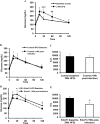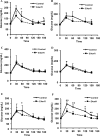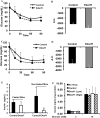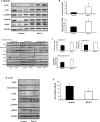An adenovirus-derived protein: A novel candidate for anti-diabetic drug development
- PMID: 26700141
- PMCID: PMC5125614
- DOI: 10.1016/j.biochi.2015.12.002
An adenovirus-derived protein: A novel candidate for anti-diabetic drug development
Abstract
Aims: Exposure to human adenovirus Ad36 is causatively and correlatively linked with better glycemic control in animals and humans, respectively. Although the anti-hyperglycemic property of Ad36 may offer some therapeutic potential, it is impractical to use an infectious agent for therapeutic benefit. Cell-based studies identified that Ad36 enhances cellular glucose disposal via its E4orf1 protein. Ability to improve glycemic control in vivo is a critical prerequisite for further investigating the therapeutic potential of E4orf1. Therefore, the aim of this study was to determine the ability of E4orf1 to improve glycemic control independent of insulin despite high fat diet.
Materials & methods: 8-9wk old male C57BL/6J mice fed a high-fat diet (60% kcal) were injected with a retrovirus plasmid expressing E4orf1, or a null vector (Control). Glycemic control was determined by glucose and insulin tolerance test. Islet cell size, amount of insulin and glucagon were determined in formalin-fixed pancreas. Rat insulinoma cell line (832/13) was infected with E4orf1 or control to determine changes in glucose stimulated insulin secretion. Protein from flash frozen adipose tissue depots, liver and muscle was used to determine molecular signaling by western blotting.
Results: In multiple experiments, retrovirus-mediated E4orf1 expression in C57BL/6J mice significantly and reproducibly improved glucose excursion following a glucose load despite a high fat diet (60% energy). Importantly, E4orf1 improved glucose clearance without increasing insulin sensitivity, production or secretion, underscoring its insulin-independent effect. E4orf1 modulated molecular signaling in mice tissue, which included greater protein abundance of adiponectin, p-AKT and Glucose transporter Glu4.
Conclusions: This study provides the proof of concept for translational development of E4orf1 as a potential anti-diabetic agent. High fat intake and impaired insulin signaling are often associated with obesity, diabetes and insulin resistance. Hence, the ability of E4orf1 to improve glycemic control despite high fat diet and independent of insulin, is particularly attractive.
Keywords: Adenoviral protein; Anti-diabetic drug; Diabetes; Glucose disposal; Glycemic control; Insulin-independent effect.
Copyright © 2015 Elsevier B.V. and Société Française de Biochimie et Biologie Moléculaire (SFBBM). All rights reserved.
Figures






Similar articles
-
E4orf1 Enhances Glucose Uptake Independent of Proximal Insulin Signaling.PLoS One. 2016 Aug 18;11(8):e0161275. doi: 10.1371/journal.pone.0161275. eCollection 2016. PLoS One. 2016. PMID: 27537838 Free PMC article.
-
E4orf1: a novel ligand that improves glucose disposal in cell culture.PLoS One. 2011;6(8):e23394. doi: 10.1371/journal.pone.0023394. Epub 2011 Aug 23. PLoS One. 2011. PMID: 21886789 Free PMC article.
-
Human adenovirus Ad36 and its E4orf1 gene enhance cellular glucose uptake even in the presence of inflammatory cytokines.Biochimie. 2016 May;124:3-10. doi: 10.1016/j.biochi.2014.11.005. Epub 2014 Nov 15. Biochimie. 2016. PMID: 25450249
-
Insulin sparing action of adenovirus 36 and its E4orf1 protein.J Diabetes Complications. 2013 Mar-Apr;27(2):191-9. doi: 10.1016/j.jdiacomp.2012.09.006. Epub 2012 Dec 12. J Diabetes Complications. 2013. PMID: 23246247 Review.
-
Potential role of E4orf1 protein in aging-associated impairment in glycemic control.J Diabetes Complications. 2019 Mar;33(3):261-265. doi: 10.1016/j.jdiacomp.2018.11.006. Epub 2018 Nov 22. J Diabetes Complications. 2019. PMID: 30578020 Review.
Cited by
-
E4orf1 Enhances Glucose Uptake Independent of Proximal Insulin Signaling.PLoS One. 2016 Aug 18;11(8):e0161275. doi: 10.1371/journal.pone.0161275. eCollection 2016. PLoS One. 2016. PMID: 27537838 Free PMC article.
-
E4orf1: A protein for enhancing glucose uptake despite impaired proximal insulin signaling.PLoS One. 2018 Dec 6;13(12):e0208427. doi: 10.1371/journal.pone.0208427. eCollection 2018. PLoS One. 2018. PMID: 30521580 Free PMC article.
-
Long-term infection passaging of Human Adenovirus 36 in monkey kidney cells.Rev Inst Med Trop Sao Paulo. 2022 Nov 14;64:e68. doi: 10.1590/S1678-9946202264068. eCollection 2022. Rev Inst Med Trop Sao Paulo. 2022. PMID: 36383890 Free PMC article.
-
E4orf1 protein reduces the need for endogenous insulin.Nutr Diabetes. 2019 May 24;9(1):17. doi: 10.1038/s41387-019-0085-x. Nutr Diabetes. 2019. PMID: 31127081 Free PMC article.
-
Adenovirus type 36 regulates adipose stem cell differentiation and glucolipid metabolism through the PI3K/Akt/FoxO1/PPARγ signaling pathway.Lipids Health Dis. 2019 Mar 21;18(1):70. doi: 10.1186/s12944-019-1004-9. Lipids Health Dis. 2019. PMID: 30902099 Free PMC article.
References
-
- Rotenstein LS, Kozak BM, Shivers JP, Yarchoan M, Close J, Close KL. The ideal diabetes therapy: what will it look like? how close are we? Clin Diabetes. 2012;30:44–53.
-
- Dhurandhar NV, Geurts L, Atkinson RL, Casteilla L, Clement K, Gerard P, Vijay-Kumar, Nam JH, Nieuwdorp M, Trovato G, Sorensen TI, Vidal-Puig A, Cani PD. Harnessing the beneficial properties of adipogenic microbes for improving human health. Obes Rev. 2013;14:721–735. - PubMed
-
- Krishnapuram R, Dhurandhar EJ, Dubuisson O, Kirk-Ballard H, Bajpeyi S, Butte, Sothern MS, Larsen-Meyer E, Chalew S, Bennett B, Gupta AK, Greenway FL, Johnson W, Brashear M, Reinhart G, Rankinen T, Bouchard C, Cefalu WT, Ye J, Javier R, Zuberi A, Dhurandhar NV. Template to improve glycemic control without reducing adiposity or dietary fat. Am J Physiol Endocrinol Metab. 2011;300:E779–E789. - PMC - PubMed
-
- Pasarica M, Shin AC, Yu M, Ou Yang HM, Rathod M, Jen KL, MohanKumar S, MohanKumar PS, Markward N, Dhurandhar NV. Human adenovirus 36 induces adiposity, increases insulin sensitivity, and alters hy-pothalamic monoamines in rats. Obes (Silver Spring) 2006;14:1905–1913. - PubMed
Publication types
MeSH terms
Substances
Grants and funding
LinkOut - more resources
Full Text Sources
Other Literature Sources
Medical

